![]()
![]()
![]()
![]()
![]()
![]()
![]()
![]()
![]()
![]()
![]()
![]()
Visual Tour of the Solar SystemVisual Tour of the Solar System - The Sun 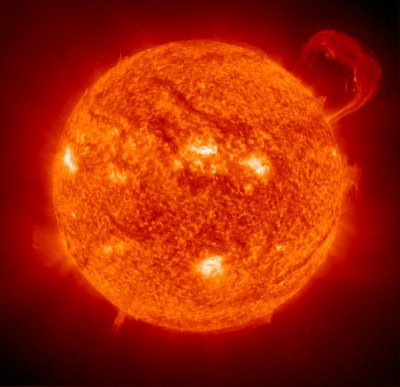
Sun - Visual Solar System Tour - The Sun
The Greeks named the sun Helios, but the Romans used the name Sol, which is still in use today. Due to the important role the sun plays in our lives, it has been studied, perhaps, more than any other object in the universe, outside our own planet Earth. The Sun is the closest star to Earth. It is by far the largest object in the solar system, and contains more than 99.8% of the total mass of the Solar System (Jupiter contains most of the rest). Its strong gravitational pull holds Earth and the other planets in the solar system in orbit. Our Sun is considered to be an average star, meaning its size, age, and temperature fall in about the middle of the ranges of these properties for all stars. It is only 4.6 billion years old. Some of its material came from former stars. This image, "Handle-shaped Prominence", Extreme Ultraviolet Imaging Telescope (EIT) image of a huge, handle-shaped prominence taken on Sept. 14,1999. Prominences are huge clouds of relatively cool dense plasma suspended in the Sun's hot, thin corona. At times, they can erupt, escaping the Sun's atmosphere. Emission in this spectral line shows the upper chromosphere at a temperature of about 60,000 degrees K. The hottest areas appear almost white, while the darker red areas indicate cooler temperatures. Let's head outward from the sun to the first planet in our solar system, Mercury. Visual Tour of the Solar System - Mercury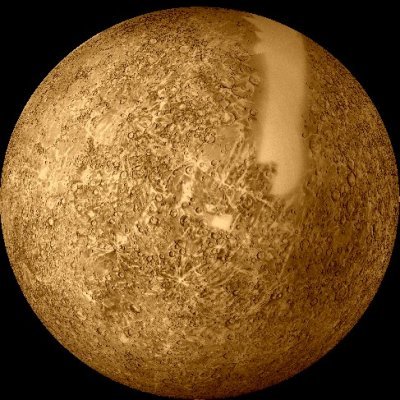
Mercury - Visual Solar System Tour -
Mercury
Mercury is a planet of extremes. It speeds around the Sun in a wildly elliptical (non-circular) orbit that takes it as close as 47 million km and as far as 70 million km from the Sun. The planet completes a trip around the Sun every 88 days, speeding through space at nearly 50 km per second, faster than any other planet. Because it is so close to the Sun, temperatures on its surface can reach a scorching 467 degrees Celsius. But because the planet has hardly any atmosphere to keep it warm, nighttime temperatures can drop to a frigid -183 degrees Celsius. Mercury has no known moons or satellites. This Image of "Mercury" was produced from USGS I-1149, 1979. After Mercury, we head further away from the sun to reach Venus. Visual Tour of the Solar System - Venus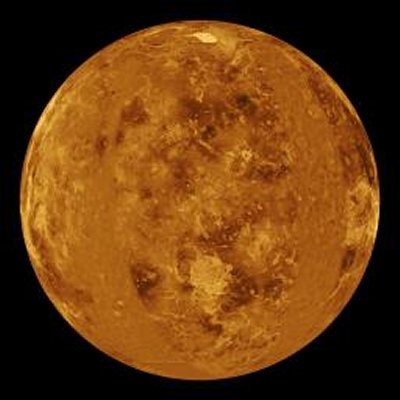
Venus - Visual Solar System Tour - Venus
At first glance, if Earth had a twin, it would be Venus. They are similar in size, mass, composition, & distance from the Sun. But there the similarities end. Venus has no ocean and is covered by thick, rapidly spinning clouds that trap surface heat, creating a scorched greenhouse-like world with temperatures hot enough to melt lead and pressure as intense as that felt 900 meters deep in Earth's oceans. Venus has no known satellites, but between the 1670s and 1770s, there were several observations of what appeared to be a satellite approximately ¼ the size of Venus. However, recent observations have not revealed any satellite. This Image of "Venus" is Centered at 0 degrees east longitude, Magellan synthetic aperture radar mosaics from the 1st cycle of Magellan mapping are mapped onto a computer-simulated globe to create this image. Gaps are filled with Pioneer Venus Orbiter data, or a constant mid-range value. Simulated color is used to enhance small-scale structure. Next, we'll be passing our home planet, Earth. Visual Tour of the Solar System - Earth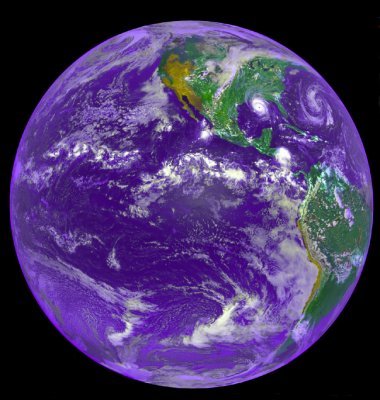
Earth - Visual Solar System Tour - Earth
Early philosophy had the Earth as the center of the universe, but Aristarchus of Samos, in the 3rd Century B.C., figured out how to measure the distances to and sizes of the Sun and the Moon, and concluded that the Earth orbited the Sun. This view didn't attract followers until Nicolaus Copernicus, a Polish astronomer, published "On the Revolutions of the Celestial Spheres" in 1543. Earth has only 1 natural satellite, the Moon at a distance of 384,000km, with a radius of 1738KM and a mass of 7.32e22kg. However, there are thousands of small artificial satellites which have been placed in orbit around the Earth. Also, asteroids 3753 Cruithne and 2002 AA29 have complicated orbital relationships with the Earth. They're not really moons, the term "companion" is used. This Image, "Hurricane Andrew" was taken on August 25, 1992 by NOAA GOES-7 weather satellite of the Americas and Hurricane Andrew as it makes landfall on the Louisiana coast. After we leave our home world, we head farther out in the solar system to Mars. Visual Tour of the Solar System - Mars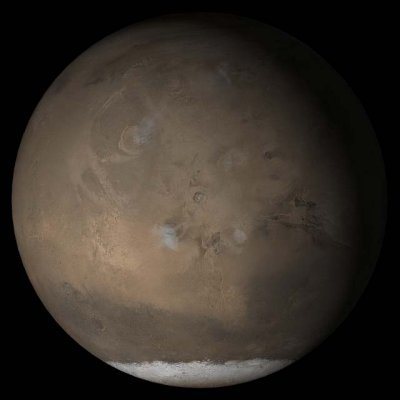
Mars - Visual Solar System Tour - Mars
Mars' atmosphere is 95 % carbon dioxide, nearly 3 % nitrogen, and nearly 2 % argon with trace quantities of oxygen, carbon monoxide, water vapor, ozone, & other trace gases. The average temperature is about -55C or -67F but can range from -133C or -207F at the winter pole to almost 27C or 80F on the day side during summer. Orbiting 227,940,000 km (1.52 AU) from Sun, the Martian year is nearly 2 Earth years, while its day is only about half an hour longer than Earth's. Mars has 2 tiny satellites which orbit very close to the surface, Phobos & Deimos. This Image of "The Red Planet" is a composite of Mars Global Surveyor (MGS) Mars Orbiter Camera (MOC) daily global images acquired at Ls 193° during a previous Mars year shows the Tharsis face of Mars. Ls, solar longitude, is a measure of the time of year on Mars. Mars travels 360° around the Sun in 1 Mars year. The year begins at Ls 0°, the start of northern spring and southern autumn. After the Red Planet, Mars, we travel even farther out to the giant planet, Jupiter. Visual Tour of the Solar System - Jupiter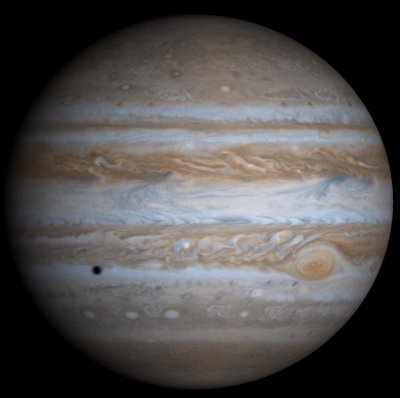
Jupiter - Visual Solar System Tour - Jupiter
Galileo was the 1st astronomer to view Jupiter through a telescope. He observed 4 satellites orbiting the planet, which supported to the Copernican theory that the Earth and other planets revolve around the Sun. Galileo's discovery was a major step forward for astronomy. With its numerous moons and several rings, the Jupiter system is a "mini-solar system." Many smaller moons have been discovered recently, but are as yet unnamed. Known named moons include: Metis, Adrastea, Amalthea, Thebe, Io, Europa, Ganymede, Callisto, Leda, Himalia, Lysithea, Elara, Ananke, Carme, Pasiphae, and Sinope. This Image of "Jupiter" is a true-color simulated view of Jupiter, composed of 4 images taken by NASA's Cassini spacecraft on December 7, 2000. To illustrate what Jupiter would have looked like if the cameras had a field-of-view large enough to capture the entire planet, the cylindrical map was projected onto a globe. Jupiter's moon Europa is casting the shadow on the planet. Cassini is a cooperative mission of NASA, the European Space Agency and the Italian Space Agency. From the giant, Jupiter, our mission continues out to that ringed wonder, Saturn. |
![]()
© Copyright 2025, Astroshops.com All rights reserved.
Unauthorized
duplication in part or whole strictly prohibited by international copyright law.
![]()
